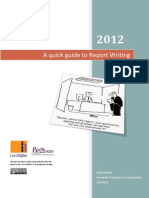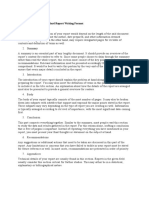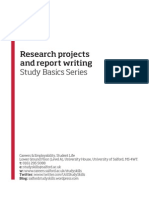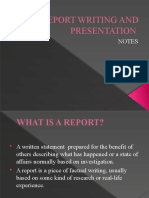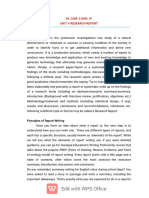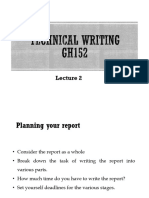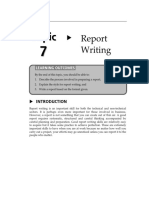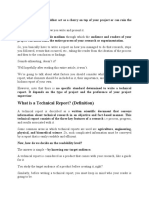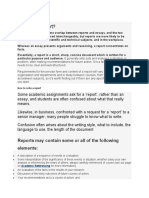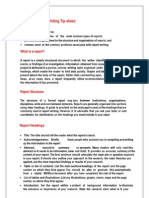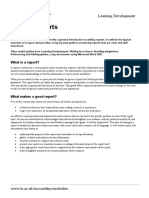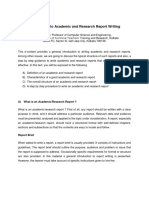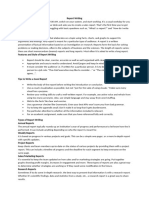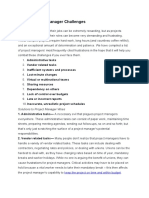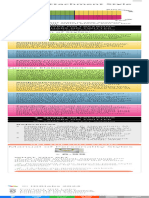Report Writing: What Is A Report?
Report Writing: What Is A Report?
Uploaded by
Ali MaherCopyright:
Available Formats
Report Writing: What Is A Report?
Report Writing: What Is A Report?
Uploaded by
Ali MaherOriginal Title
Copyright
Available Formats
Share this document
Did you find this document useful?
Is this content inappropriate?
Copyright:
Available Formats
Report Writing: What Is A Report?
Report Writing: What Is A Report?
Uploaded by
Ali MaherCopyright:
Available Formats
REPORT WRITING
This study advice sheet highlights common features in written reports and makes
recommendations for clear presentation and a conventional format.
What is a report?
A report is a more highly structured form of writing than an essay, and is designed so that it can
be read quickly and accurately; though reports are not necessarily read from beginning to end.
Structure and convention in written reports stress the process by which the information was
gathered as much as the information itself. Reports should be organised for the convenience of
the intended reader. Reports are written on a wide range of subjects for a wide variety of reasons.
Before writing any report you should identify the objective and the preferred conventions of
structure and presentation. This is as true for reports you write at university as it is for reports
written in employment.
All reports attempt to communicate findings for one reason or another, whether to inform decision
makers, change public opinion or maintain a record of development. Whenever you write a report
you must bear in mind why you are writing and who you are writing for. All reports have an
intended reader. Put yourself in his/her position. What does he/she need to know?
Stages in report writing
The following stages are involved in writing a report:
planning your work;
collecting your information;
organising and structuring your information;
writing the first draft;
checking and re-drafting.
Draw up an outline structure for your report and set the work within a sensible time scale for
completion by the given deadline. One common structure is based on the 4 P’s: position, problem,
possibilities, proposal. This means you outline the current position, describe the problem, examine
the range of possibilities and decide on a proposal (Hemingway, 1993). Some of the most
time-consuming parts of the process are collecting and selecting your information, and checking
and revising your report.
Clarify your terms of reference – what brief are you working to?
Decide on the main sections of your report – what instructions have you been given?
Note for students on modules LLP002, LLP207, LLP312 and LLP314: Your assessment brief
on Learn will have specific details on the main sections you should include in your report. These
may not be the same as the structure suggested in this advice sheet. However, the
recommendations on Presentation, Style of Writing, Layout and the Checklists in this advice sheet
are still relevant.
Examples of different types of reports
Research report: https://www.nesta.org.uk/publications/state-art-analysing-where-art-meets-
technology-using-social-network-data
Industry analysis: http://www.designcouncil.org.uk/resources/report/design-economy-report
Market research: http://academic.mintel.com/display/793761/ (Access on Campus or via VPN)
Structuring your report
Check with your tutor to find out what your report should include and how it should be presented.
The following elements are however common to many reports:
• Title page
This should include the title of the report (which should give a precise indication of the subject
matter), the author(s)’s name(s), module, and the date.
• Acknowledgements
You should acknowledge any help you have received in collecting the information for the
report, for example from staff in your department, support services or external companies.
• Contents
You should list all the main sections of the report in sequence with the page numbers they
begin on. If there are charts, diagrams or tables included in your report, these should be listed
separately under a title such as ‘List of Illustrations’ together with the page numbers on which
they appear.
• Abstract or executive summary
This should be a short paragraph summarising the main contents of the report. It should
include a short statement of the main task, the methods used, conclusions reached and any
recommendations made. The abstract or summary should be concise, informative and
independent of the report. The summary may have more than one purpose: it reminds the
reader what they have read but it is also useful to busy managers or professors who may not
always read the full report.
Write this section after you have written the main body of the report.
• Introduction
This should give the context and scope of the report and should include your terms of
reference (what have you been asked to find out?) State your objectives clearly, define the
limits of the report, outline the method of enquiry, give a brief general background to the
subject of the report e.g. the company or procedure, and indicate the proposed development.
• Methodology
In this section you should state how you carried out your enquiry. What form did your enquiry
take? Did you carry out interviews or questionnaires, how did you collect your data? What
measurements did you make? How did you choose the subjects for your interviews?
• Results or findings
Present your findings in as simple a way as possible. The more complicated the information
looks, the more difficult it will be to interpret. Graphs, charts and diagrams help your reader
identify key results and will break the flow of written text.
• Discussion
This is the section where you analyse and interpret your results drawing from the information which
you have collected, explaining its significance. Identify important issues and suggest explanations
for your findings. Outline any problems encountered and try and present a balanced view.
• Conclusions and recommendations
This is the section of the report which draws together the main issues. It should be expressed
clearly and should not present any new information. You may wish to list your recommendations in
a separate section or include them with the conclusions.
• References
It is important that you give precise and accurate details of all the work by other authors which has
been referred to within the report. References are normally listed in alphabetical order by the
authors' names or in numerical order. Check your Department handbook to find out what
referencing format is required by your Department.
Appendices
An appendix contains additional related information which is not essential to read but can be
consulted if the reader wishes. However, the interpretation of the report should not depend on this
being read. You could include details of interview questions, statistical data, a glossary of terms, or
other such information.
Presentation
Your report should be easy to read. What are the requirements for your module?
• Paragraphs should be short and concise. They should be spaced apart.
• Avoid rambling by using short sentences.
• Avoid using unnecessary jargon and unexplained abbreviations.
• List your standard measurements, units and technical terminology in a glossary at the end.
• Headings should be clear – highlighted in bold or underlined.
• Label graphs, pictures or drawings as 'Figures', e.g. Figure 1, Figure 2 etc.
• Tables of information should be labelled separately, e.g. Table 1, Table 2 etc.
Style of writing
Keep it simple. Avoid sentences that are too long and eliminate unnecessary jargon. Your tutor will
be able to advise whether the report should be written in the ‘active’ or ‘passive’ voice.
The active voice reads as follows: ‘I recommend ...’
The passive voice reads: ‘It is recommended that ...’
The active voice allows you to write short, punchy sentences. The passive appears more formal and
considered and is more suitable for academic writing. Avoid mixing the two voices.
In which voice will you be expected to write?
Layout
Most reports have a progressive numbering system. The main sections are given single numbers -
1, 2, 3 and so on.
Subsections are given a decimal number- 1.1, 1.2, 1.3 etc.
Subsections can be further divided- 1.1.1, 1.1.2, 1.1.3, 1.2.1, 1.2.2 etc.
Redrafting and checking
Once you have written the first draft of your report you will need to check it through. It is
probably sensible to leave it on your desk for a day or so if you have the time. This will make a
clear break from the intensive writing period, allowing you to view your work more objectively.
Assess your work by re-reading particularly focusing on:
• structure,
• content,
• style.
Report writing checklist
7. Results and findings
1. Title page
Are your diagrams clear and simple?
Does this include the: Are they clearly labelled?
title? Do they relate closely to the text?
author(s)’s name(s)?
module details? 8. Discussion
Have you identified key issues?
2. Acknowledgements Have you suggested explanations for your
Have you acknowledged all sources of help? findings?
Have you outlined any problems encountered?
3. Contents Have you presented a balanced view?
Have you listed all the main sections in sequence?
Have you included a list of illustrations? 9. Conclusions and recommendations
Have you drawn together all of your main ideas?
4. Abstract or summary Have you avoided including any new
Does this state the: information?
main task? Are your recommendations clear and concise?
methods used?
conclusions reached? 10. References
recommendations made? Have you listed all references?
Have you included all the necessary information
5. Introduction for locating each reference?
Does this include: Are your references accurate and consistent?
your terms of reference?
the limits of the report? 11. Appendices
an outline of the method? Have you only included supporting information?
a brief background to the subject matter? Does the reader need to read these sections?
6. Methodology 12. Writing style
Does this include: Have you used clear and concise language?
the form your enquiry took? Are your sentences short and jargon free?
the way you collected your data? Are your paragraphs tightly focused?
Have you used the active or the passive voice?
Illustrations checklist
All illustrations should be carefully presented to help convey your information:
• Are all your illustrations clearly labelled?
• Do they all have titles?
• Is the link between the text and diagram clear?
• Are the headings precise?
• Are the axes of graphs clearly labelled?
• Can tables be easily interpreted?
• Have you acknowledged all sources and obtained permission to reproduce copyright images?
• Have you numbered your illustrations and listed them in the Contents section?
You might also like
- Voice Preachers GuideDocument108 pagesVoice Preachers GuideSantosh Jagtap83% (6)
- Training of Trainers On Empowerment and Re-Affirmation of Paternal Abilities (ERPAT) ManualDocument62 pagesTraining of Trainers On Empowerment and Re-Affirmation of Paternal Abilities (ERPAT) ManualGerald A. Antonio90% (10)
- Internship Report FormatDocument4 pagesInternship Report FormatShan MalikNo ratings yet
- Report WritingDocument4 pagesReport WritingrebNo ratings yet
- Report Writing-1Document6 pagesReport Writing-1nasreenkumari612No ratings yet
- DocumentDocument16 pagesDocumentlivinus ochikeNo ratings yet
- Report WritingDocument6 pagesReport WritingHoney QaisarNo ratings yet
- How To Write A ReportDocument5 pagesHow To Write A Reportw9fsttgpjcNo ratings yet
- Work Based Project Session 3Document30 pagesWork Based Project Session 3Barbaroncea BarbarulNo ratings yet
- Reports Business 2023Document6 pagesReports Business 2023jeramieolinNo ratings yet
- What Is Report Writing?Document7 pagesWhat Is Report Writing?mohsin iqbalNo ratings yet
- Andy Reports - Short Version 2012Document10 pagesAndy Reports - Short Version 2012Andy MitchellNo ratings yet
- Report WritingDocument30 pagesReport WritingArefin ChyNo ratings yet
- Title Section: Report For Business Main Elements of The Standard Report Writing FormatDocument14 pagesTitle Section: Report For Business Main Elements of The Standard Report Writing FormatSekar Sabina LarasatiNo ratings yet
- Report Writing-1Document9 pagesReport Writing-1Ali MaherNo ratings yet
- Writing Technical ReportsDocument5 pagesWriting Technical ReportssmithNo ratings yet
- A Quick Guide To Report Writing: Andy Mitchell Study Hub 1/1/2012Document10 pagesA Quick Guide To Report Writing: Andy Mitchell Study Hub 1/1/2012David WilliamsNo ratings yet
- Week-3 (1)Document20 pagesWeek-3 (1)tasimuddinsohanNo ratings yet
- Report WritingDocument7 pagesReport WritingManinder KaurNo ratings yet
- Research Projects and Report Writing - BINDERDocument8 pagesResearch Projects and Report Writing - BINDERAhmed Haji100% (1)
- AssignDocument5 pagesAssignAbdulwedud NuredinNo ratings yet
- Report Structure Report WritingDocument1 pageReport Structure Report WritingC Learning100% (1)
- WRITING A REPORT LessonDocument3 pagesWRITING A REPORT LessonMariella MallariNo ratings yet
- TW, Report WritingDocument35 pagesTW, Report Writingsaleem.smNo ratings yet
- English For Academic and Professional Purposes: Learning Module 4: Objectives and Structures of Various Kinds of ReportsDocument6 pagesEnglish For Academic and Professional Purposes: Learning Module 4: Objectives and Structures of Various Kinds of ReportsReymart YagamiNo ratings yet
- Business ReportDocument6 pagesBusiness ReportRanga Reddy100% (1)
- Business Report WritingDocument6 pagesBusiness Report WritingDr Hector C Sikazwe100% (4)
- 1 Report WritingDocument32 pages1 Report WritingAyesha Tahir100% (1)
- Report Writing: Study Advice Study GuidesDocument7 pagesReport Writing: Study Advice Study GuidesZuk V CastilloNo ratings yet
- Writing A Report: Survival GuideDocument2 pagesWriting A Report: Survival GuideWendy GuNo ratings yet
- Report Writing and Presentation: NotesDocument65 pagesReport Writing and Presentation: NotesHabibou Jasseh100% (1)
- Script Chương mở đầuDocument10 pagesScript Chương mở đầuptkquyen1746No ratings yet
- SENIOR HIGH SCHOOL-English For Academic and Professional PurposesDocument8 pagesSENIOR HIGH SCHOOL-English For Academic and Professional Purposesjoshua herrera100% (2)
- Research ReportDocument9 pagesResearch Reportrajjj8855No ratings yet
- Report Writing: 1.1 Identify The Purpose of The ReportDocument8 pagesReport Writing: 1.1 Identify The Purpose of The ReportmkdempsNo ratings yet
- Lecture 2 - GH152Document31 pagesLecture 2 - GH152AlaaeeeNo ratings yet
- Report Writing LECTURE 9Document19 pagesReport Writing LECTURE 9Concerned CitizenNo ratings yet
- TC Unit2 FinalDocument21 pagesTC Unit2 Finalsrivastavaamritansh02No ratings yet
- Case StudyDocument3 pagesCase StudysembatstateuNo ratings yet
- The Technical ReportsDocument40 pagesThe Technical ReportsprettynaugthyNo ratings yet
- Technical Report WritingDocument6 pagesTechnical Report WritingHamza JavedNo ratings yet
- Communication For Work Purposes: Week 5: Lesson 3Document5 pagesCommunication For Work Purposes: Week 5: Lesson 3Noreen seah banaynal SaripNo ratings yet
- What Is A Report?: Reports May Contain Some or All of The Following ElementsDocument4 pagesWhat Is A Report?: Reports May Contain Some or All of The Following Elementssaira azeemNo ratings yet
- Research Report WritingDocument11 pagesResearch Report WritingAbdirahman100% (1)
- What Is A ReportDocument7 pagesWhat Is A ReportFrances FranciscoNo ratings yet
- How Do I Write A ReportDocument2 pagesHow Do I Write A ReportDr_M_Soliman100% (2)
- Script Chapter 1.1Document4 pagesScript Chapter 1.1ptkquyen1746No ratings yet
- Module 16b Report WrittingDocument8 pagesModule 16b Report WrittingLilian mutuotaNo ratings yet
- What Is Interpretation ? Why It Is Necessary ?Document31 pagesWhat Is Interpretation ? Why It Is Necessary ?sanjay29872No ratings yet
- Eapp Module2 Q2W4Document21 pagesEapp Module2 Q2W4Lireea GhustaNo ratings yet
- What Is A ReportDocument4 pagesWhat Is A ReportMariaNo ratings yet
- Report Writing Tip SheetDocument3 pagesReport Writing Tip SheetDr_M_SolimanNo ratings yet
- Lecture1and2 GH152Document38 pagesLecture1and2 GH152rashidalawi969No ratings yet
- Writing Reports: Learning DevelopmentDocument6 pagesWriting Reports: Learning DevelopmentJane BerryNo ratings yet
- Primer To IMRD ReseachDocument38 pagesPrimer To IMRD ReseachTeofztogo PalsimonNo ratings yet
- Writing A Case StudyDocument4 pagesWriting A Case StudyJasmine ComayingkingNo ratings yet
- E-Content #01 (SR) Introduction To Academic and Research Report WritingDocument6 pagesE-Content #01 (SR) Introduction To Academic and Research Report Writingaravind mouryaNo ratings yet
- Report WritingDocument3 pagesReport Writingmdanish63450No ratings yet
- Study Bites - Writing Reports 09-09-2010Document7 pagesStudy Bites - Writing Reports 09-09-2010shanuhiteshNo ratings yet
- Unit 5 Lecture NoteDocument6 pagesUnit 5 Lecture NoteJulius EtukeNo ratings yet
- ChatGPT Guide to Scientific Thesis Writing: AI Research writing assistance for UG, PG, & Ph.d programsFrom EverandChatGPT Guide to Scientific Thesis Writing: AI Research writing assistance for UG, PG, & Ph.d programsRating: 4 out of 5 stars4/5 (1)
- Stress BrochureDocument3 pagesStress Brochureapi-545708059No ratings yet
- Ashley Hobson Let's Get Rockin': Classifying Rocks Dates Taught: September 23 To October 11 2 Grade ScienceDocument42 pagesAshley Hobson Let's Get Rockin': Classifying Rocks Dates Taught: September 23 To October 11 2 Grade Scienceapi-236126271No ratings yet
- Occ Long Quiz ReviewerDocument3 pagesOcc Long Quiz Revieweriesha limNo ratings yet
- Viewpoint Development Process: The Planes of Existence and KundaliniDocument4 pagesViewpoint Development Process: The Planes of Existence and KundaliniCLGNo ratings yet
- Kerig1995 - Triangles in The Family CircleDocument16 pagesKerig1995 - Triangles in The Family CircleLuminita TomiNo ratings yet
- Paper ReadingDocument3 pagesPaper ReadingRintan Novia Safitri0% (1)
- MN4503 Course InfoDocument2 pagesMN4503 Course InfoHETeenNo ratings yet
- Summary CH 15 - Audit SamplingDocument5 pagesSummary CH 15 - Audit Samplingbiana100% (1)
- Tourists' Satisfaction With A DestinationDocument20 pagesTourists' Satisfaction With A DestinationSpmr RajaNo ratings yet
- Linguistic TermsDocument3 pagesLinguistic TermsMuhammad ArifNo ratings yet
- Top 10 Project Manager ChallengesDocument3 pagesTop 10 Project Manager ChallengesMohamed Yusuf KarieNo ratings yet
- TFN - TRANSES PDFDocument6 pagesTFN - TRANSES PDFPatrisha Isabelle D. DumaranNo ratings yet
- Unit IIDocument9 pagesUnit IIShoba GuhanNo ratings yet
- Learner'S Needs, Progress and Achievement Cardex: Malinao School For Philippine CraftsmenDocument1 pageLearner'S Needs, Progress and Achievement Cardex: Malinao School For Philippine CraftsmenMarissa BrionesNo ratings yet
- Daniels Cap 2Document17 pagesDaniels Cap 2Samuel AraújoNo ratings yet
- SMITH, Barbara Fletchman - Transcending The Legacies of Slavery - A Psychoanalytic ViewDocument142 pagesSMITH, Barbara Fletchman - Transcending The Legacies of Slavery - A Psychoanalytic ViewThiago Ponce de MoraesNo ratings yet
- Assignment 1 bm102Document6 pagesAssignment 1 bm102Star69 Stay schemin2No ratings yet
- Project 2 Mission StatementDocument4 pagesProject 2 Mission StatementmaddynithiaNo ratings yet
- Engl 1101 SyllabusDocument4 pagesEngl 1101 Syllabusapi-237781380No ratings yet
- Discourse AnalysisDocument105 pagesDiscourse Analysismeymirah100% (5)
- Practice Test - Error IdentificationDocument5 pagesPractice Test - Error IdentificationTùng Lâm TrầnNo ratings yet
- MEAL-DPro-03 29 2019Document141 pagesMEAL-DPro-03 29 2019jwmeadow2401100% (1)
- Journal of Air Transport Management: ArticleinfoDocument6 pagesJournal of Air Transport Management: ArticleinfoYuni SartikaNo ratings yet
- Motor Learning TheoriesDocument30 pagesMotor Learning TheoriesSardarChangezKhanNo ratings yet
- Smart Attachment Style TestDocument1 pageSmart Attachment Style Testnakirina.14No ratings yet
- Philosophical Beauty: Robert PasnauDocument14 pagesPhilosophical Beauty: Robert PasnauMichael Fernandez ArevaloNo ratings yet
- 11.1 Rubric Project Met 2017-20181Document9 pages11.1 Rubric Project Met 2017-20181abdussalamNo ratings yet
- Mintzberg Managerial RolesDocument2 pagesMintzberg Managerial RolesAhmed TallanNo ratings yet











